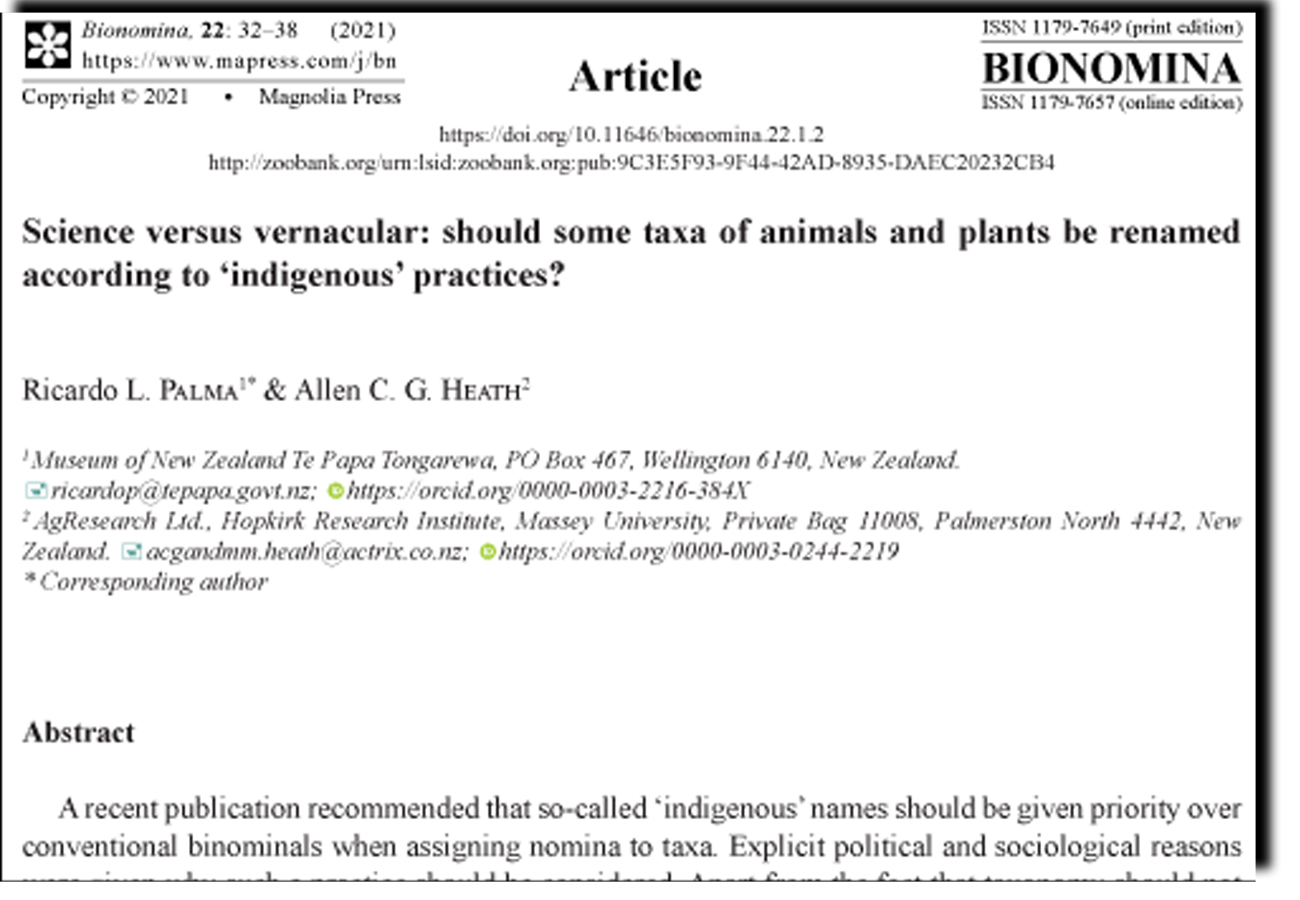Abstract
A recent publication recommended that so-called ‘indigenous’ names should be given priority over conventional binominals when assigning nomina to taxa. Explicit political and sociological reasons were given why such a practice should be considered. Apart from the fact that taxonomy should not be used as an agent for cultural change, a system that has been in unquestioned use for over 250 years has clearly unambiguity, utility, precision and standardisation in its favour, and is also supported and defined by carefully considered rules. In this rebuttal, reasons are given for the value and continuance of the current nomenclatural system and it is argued that the concept of indigeneity as applied to humans is not only questionable, but imprecise. Difficulties with deciding priority within a melange of languages and dialects overlain by diasporic movements, as well as the narrow range of available terms for biota in native languages, adds to the inutility of the system that is being argued against here, and which we reject utterly.
References
Anonymous [International Commission on Zoological Nomenclature] (1999) International code of zoological nomenclature. Fourth edition. London (The International Trust for Zoological Nomenclature): i‒xxx + 1‒306.
Anonymous (2020) Emu. Aboriginal information. <https://mdahlem.net/birds/1/emu_abo.php>. [Last updated 8 September 2020, accessed 18 February 2021].
Cavalli-Sforza, L. L. & Cavalli-Sforza, F. (1995) The great human diasporas. Reading, Massachusetts (Perseus Books): i‒xiii + 1‒300.
Dubois, A. (2005) Proposed rules for the incorporation of nomina of higher-ranked zoological taxa in the International Code of Zoological Nomenclature. 1. Some general questions, concepts and terms of biological nomenclature. Zoosystema, 27: 365–426. <https://doi.org/10.11646/zootaxa.1337.1.1>.
Dubois, A. (2010) Zoological nomenclature in the century of extinctions: priority vs. ‘usage’. Organisms, Diversity and Evolution, 10: 259–274. <https://doi.org/10.1007/s13127-010-0021-3>.
Dubois, A. (2011) The multiple meanings of ancient zoological terms. Bionomina, 4: 73–75. <https://doi.org/10.11646/bionomina.4.1.4>.
Dubois, A., Ohler, A., Pyron, R. A. (2021) New concepts and methods for phylogenetic taxonomy and nomenclature in zoology, exemplified by a new ranked cladonomy of recent amphibians (Lissamphibia). Megataxa, 5: 1–738.
Fischer, S. R. (1999) A history of language. London (Reaktion Books Limited): 1‒240.
Galbreath, R. (2021) Why have so few Maori or Moriori names been used in taxonomic descriptions? New Zealand Journal of Ecology, 45: 1‒3. <https://doi.org/10.20417/nzjecol.45.16>.
Gill, B. J., Bell, B. D., Chambers, G. K., Medway, D. G., Palma, R. L., Scofield, R. P., Tennyson, A. J. D. & Worthy, T. H. [O.S.N.Z. Checklist Committee] (2010) Checklist of the birds of New Zealand, Norfolk and Macquarie Islands, and the Ross Dependency, Antarctica. Fourth Edition. Wellington, New Zealand (Ornithological Society of New Zealand & Te Papa Press): i‒x + 1‒501.
Gillman, L. N. & Wright, S. D. (2020) Restoring indigenous names in taxonomy. Communications Biology, 3 (609): 1‒3. <https://doi.org/10.1038/s42003-020-01344-y>.
Heath, A. C. G. & Palma, R.L. (2017) A new species of tick (Acari: Ixodidae) from seabirds in New Zealand and Australia, previously misidentified as Ixodes eudyptidis. Zootaxa, 4324 (2): 285–314. <https://doi.org/10.11646/zootaxa.4324.2.4>.
King, M. (2000) Moriori, a people rediscovered. Revised edition. Auckland, New Zealand (Viking, Penguin Books Ltd.): 1‒227.
Lincoln, R., Boxshall, G. & Clark, P. (1998) A dictionary of ecology, evolution and systematics. Cambridge, United Kingdom (Cambridge University Press): i‒ix + 1‒361.
Murray, D. (2019). The madness of crowds. Gender, race and identity. London (Bloomsbury Continuum): 1‒280.
Miller, D. (1952) The insect people of the Maori. Journal of the Polynesian Society, 61: 1–61.
Onions, C. T. (reviser & editor) (1973) The shorter Oxford English dictionary on historical principles. Volumes 1 & 2. Oxford (Clarendon Press): volume 1, i‒xxii +1‒1280; volume 2: i‒vii + 1‒1392.
Scruton, R. (2019) Fools, frauds and firebrands. London (Bloomsbury Continuum): i‒vii + 1‒296.
Turland, N. J., Wiersema, J. H., Barrie, F. R., Greuter, W., Hawksworth, D. L., Herendeen, P. S., Knapp, S., Kusber, W.-H., Li, D.-Z., Marhold, K., May, T. W., McNeill, J., Monro, A. M., Prado, J., Price, M. J. & Smith, G. F. (ed.) (2018) International code of nomenclature for algae, fungi, and plants (Shenzhen Code) adopted by the Nineteenth International Botanical Congress Shenzhen, China, July 2017. Regnum Vegetabile, 159. Glashütten, Germany (Koeltz Botanical Books). <https://doi.org/10.12705/Code.2018>.


